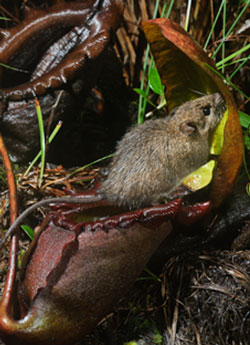Rats, bats and pitcher plants
Although the pitchers on tropical pitcher plants mostly attract and digest insects, some pitcher plants actually use nectar to attract—but not digest—rats and treeshrews.1,2

These small mammals fit just right atop the pitcher’s openings, and they use the pitcher as a toilet. The plant collects nutritious nitrogen at the bottom of its pitcher from the animal waste. Some pitcher plants actually provide a home for bats in trade for fertilizer. Pretty clever setups. New results clarify just how this setup works, and how it is unexplainable by evolution.
South and Central American pitcher plants were already known to have flowers that attract bats for pollination. Now pitcher plants in Borneo have been shown to attract bats for their excrement, which adds 34% more nitrogen when bats roost in the pitcher.3 In return, the pitcher plant supplies the bats a daytime roost with no parasites, and with bat-friendly temperature and humidity. This is just the right size to accommodate one or two bats at the top of the pitcher while the shape prevents them from reaching the digestive liquid at the bottom of the pitcher.

How do the bats find these homes amidst myriad jungle greenery? First, they emit “broadband and high pitched” sonar frequencies. Researchers wrote that “such a call design” helps them navigate through dense forest foliage.3 But these bats’ sound frequencies can also target sonar reflectors on the pitcher plants.
Second, a lid-like extension rises above each pitcher’s opening. It displays a reflector with four precisely tuned qualities:
- Its concave shape sounds louder to the bat than the surroundings— recall echoes made by yelling into a radar dish.
- The hollow tube below the loud reflector absorbs sound, creating a distinct volume contrast for bats to recognize.
- The extension is larger than that of other pitcher plants (which don’t have a bat reflector there), increasing its sonic ‘visibility.’
- It reflects distinct patterns on either side enabling the bats to detect it from many angles.
Together, these features make it as easy for these bats to find their pitcher plant hovels as a driver using a GPS device to locate home.

Creation-deniers now face the challenging task of describing how mere natural processes could have evolved the features that enable this mutualism. Mutualism refers to interactions between totally different organisms that benefit one another. Current Biology study authors discussing this wrote, “How mutualisms evolve … is still not sufficiently understood.” 4 Could these interdependent, mutualism-generating designs ever have evolved? Bat squeaks do not program reflector-building instructions into plant DNA.
In the end, the researchers merely kicked this question down the road, saying, “further studies will be necessary” to understand how “such complex plant-animal interactions … evolved.”3 I’d like to pitch them my ‘batty’ idea: Since natural causes like wind or predators never construct functional features like sonar emitters, reflectors or detectors, maybe a supernatural cause like the Creator God best explains them.
References and notes
- Greenwood, M., et al., A unique resource mutualism between the Giant Bornean Pitcher Plant, Nepenthes rajah, and members of a small mammal community, PLoS One 6(6):e21114, 2011 | doi:10.1371/journal.pone.0021114. Return to text.
- Sarfati, J., Pitcher plants and animal sanitation, Creation 37(1):29, 2015. Return to text.
- Grafe, T.U. et al., A novel resource-service mutualism between bats and pitcher plants, Biology Letters 7:436–439, 12 May 2011 | doi:1098/rsbl.2010.1141. Return to text.
- Schöner, M.G. et al., Bats are acoustically attracted to mutualistic carnivorous plants, Current Biology 25(14):1911–1916, 20 July 2015 | doi:10.1016/j.cub.2015.05.054. Return to text.





Readers’ comments
Comments are automatically closed 14 days after publication.